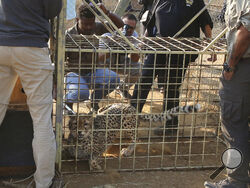NEW DELHI (AP) — Seven decades after cheetahs died out in India, they're back.
Eight big cats from Namibia made the long trek Saturday in a chartered cargo flight to the northern Indian city of Gwalior, part of an ambitious and hotly contested plan to reintroduce cheetahs to the South Asian country.
Then they were moved to their new home: a sprawling national park in the heart of India where scientists hope the world’s fastest land animal will roam again.
Indian Prime Minister Narendra Modi released the cats into their enclosure Saturday morning. The cats emerged from their cage, tentatively at first while continuously scanning their new surroundings.
“When the cheetah will run again … grasslands will be restored, biodiversity will increase and eco-tourism will get a boost,” said Modi.
Cheetahs were once widespread in India and became extinct in 1952 from hunting and loss of habitat. They remain the first and only predator to die out since India’s independence in 1947. India hopes importing African cheetahs will aid efforts to conserve the country's threatened and largely neglected grasslands.
There are less than 7,000 adult cheetahs left in the wild globally, and they now inhabit less than 9% of their original range. Shrinking habitat, due to the increasing human population and climate change, is a huge threat and India's grasslands and forests could offer “appropriate” homes for the big cat, said Laurie Marker, of the Cheetah Conservation Fund, an advocacy and research group assisting in bringing the cats to India.
“To save cheetahs from extinction, we need to create permanent places for them on earth," she said.
Cheetah populations in most countries are declining. An exception to this is South Africa, where the cats have run out of space. Experts hope that Indian forests could offer these cats space to thrive. There are currently a dozen cheetahs in quarantine in South Africa, and they are expected to arrive at the Kuno National Park soon. Earlier this month, four cheetahs captured at reserves in South Africa were flown to Mozambique, where the cheetah population has drastically declined.
Some experts are more cautious.
There could be “cascading and unintended consequences” when a new animal is brought to the mix, said Mayukh Chatterjee of the International Union for Conservation of Nature.
For example, a tiger population boom in India has led to more conflict with people sharing the same space. With cheetahs, there are questions about how their presence would affect other carnivores like striped hyenas, or even prey like birds.
“The question remains: How well it's done,” he said.
The initial eight cheetahs from Namibia will be quarantined at a facility in the national park and monitored for a month to make sure they're not carrying pests. Then they will be released into a larger enclosure in the park to help them get used to their new environment. The enclosures contain natural prey — such as spotted deer and antelope, which scientists hope they'll learn to hunt — and are designed to prevent other predators like bears or leopards from getting in.
The cheetahs will be fitted with tracking collars and released into the national park in about two months. Their movements will be tracked routinely, but for the most part, they'll be on their own.
The reserve is big enough to hold 21 cheetahs and if they were to establish territories and breed, they could spread to other interconnected grasslands and forests that can house another dozen cheetahs, according to scientists.
There is only one village with a few hundred families still residing on the fringes of the park. Indian officials said they'd be moved soon, and any livestock loss due to cheetahs will be compensated. The project is estimated to cost $11.5 million over five years, including $6.3 million that will be paid for by state-owned Indian Oil.
The continent-to-continent relocation has been decades in the making. The cats that originally roamed India were Asiatic cheetahs, genetically distinct cousins of those that live in Africa and whose range stretched to Saudi Arabia.
India had hoped to bring in Asiatic cheetahs, but only a few dozen of these survive in Iran and that population is too vulnerable to move.
Many obstacles remain, including the presence of other predators in India like leopards that may compete with cheetahs, said conservation geneticist Pamela Burger of University of Veterinary Medicine in Vienna.
“It would be better to conserve them now where they are than to put effort in creating new sites where the outcome is questionable,” she said.
Dr. Adrian Tordiffe, a veterinary wildlife specialist from South Africa associated with the project, said the animals need a helping hand. He added that conservation efforts in many African countries hadn't been as successful, unlike in India where strict conservation laws have preserved big cat populations.
“We cannot sit back and hope that species like the cheetah will survive on their own without our help," he said.
___
The Associated Press Health and Science Department receives support from the Howard Hughes Medical Institute’s Department of Science Education. The AP is solely responsible for all content.

